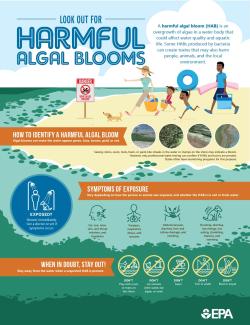Protecting the Huron River, River Raisin, and Western Lake Erie Basin
Harmful algal blooms (HABs) are a growing threat to water quality, human and animal health, and our local economies. In southeastern Michigan, excessive nutrient runoff—especially phosphorus—from agricultural and urban landscapes contributes to HABs in the Huron River and River Raisin watersheds, both of which drain into the Western Lake Erie Basin.
As a Conservation District serving Washtenaw County, we work closely with farmers, landowners, and local partners to implement voluntary conservation practices that prevent nutrient runoff and protect our shared water resources.

What Are Harmful Algal Blooms (HABs)?
HABs occur when algae—primarily cyanobacteria or "blue-green algae"—rapidly grow in nutrient-rich freshwater. These blooms:
- Deplete oxygen in water, harming fish and aquatic life
- Produce toxins harmful to humans, pets, and livestock
- Disrupt recreation, tourism, and drinking water supplies
- Impact downstream ecosystems, including Lake Erie
In Michigan, HABs often form during the warm summer and fall months, particularly in slow-moving or nutrient-rich waterbodies like lakes, ponds, and impoundments. Tributaries such as the Huron River and River Raisin feed into Lake Erie, meaning local nutrient runoff has regional consequences.
How Agriculture Contributes—and Can Help
While agriculture is a cornerstone of our region’s economy, it can be a source of nutrient runoff when fertilizers, animal waste, and soil wash into ditches, drains, and streams. However, farmers are also leading the way in implementing practices that prevent runoff and improve water quality.
Conservation Practices That Prevent HABs:
WCCD promotes a range of voluntary, science-based practices that reduce phosphorus and sediment loss at the field level, including:
- Cover Crops: Planted after harvest to hold soil in place, absorb nutrients, and improve soil health.
- No-Till or Reduced Tillage: Reduces soil disturbance, improving infiltration and limiting erosion.
- Grassed Waterways & Filter Strips: Vegetated areas that trap sediment and absorb nutrients before they reach waterways.
- Nutrient Management Plans: Help farmers apply the right amount of fertilizer at the right time, reducing runoff risks.
- Drainage Water Management: Controls the timing and amount of water leaving farm fields.
- Riparian Buffers: Permanent vegetated areas along streams that filter runoff and provide habitat.
Each of these practices not only protects water quality but also builds long-term soil health and farm resilience.
Huron and Raisin Rivers’ Role in the Western Lake Erie Basin
The Huron and River Raisin are key tributaries in the Western Lake Erie Basin (WLEB), an area known for persistent summer algal blooms. In 2014, a toxic bloom in Lake Erie left over 400,000 Toledo residents without safe drinking water. Although the Maumee River is the largest phosphorus source, reducing nutrient inputs from all tributaries—including those in Washtenaw County—is essential to regional recovery.
By supporting farmers and landowners here at home, we contribute to the health of both our local rivers and the broader Great Lakes ecosystem.
What WCCD Is Doing
We work in partnership with local farmers, Natural Resource Conservation Service (NRCS), Michigan Agriculture Environmental Assurance Program (MAEAP), the Huron River Watershed Council, the River Raisin Watershed Council, and other regional stakeholders to:
- Support conservation planning and implementation through one-on-one technical assistance
- Offer cost-share funding to make on-farm conservation more accessible
- Conduct outreach and education on HABs, nutrient management, and watershed health
- Promote MAEAP verification, a voluntary program recognizing farms for environmental stewardship
- Track impacts through state and federal conservation reporting tools
What You Can Do
Whether you’re a farmer, landowner, or resident, you can help reduce nutrient pollution and protect our rivers:
- Adopt conservation practices like cover crops, no-till, nutrient management plans, and rain gardens
- Protect wetlands, riparian buffers, and natural areas on your land
- Report suspected HABs to EGLE at algaebloom@michigan.gov
- Check before you recreate: EGLE HAB Map
- Volunteer or donate
Learn More or Get Involved
Join Michigan Sea Grant’s FREE "HABs 101: Lake Stories" webinar on August 6, 2025 (6–7:30 PM ET). Hear from Michiganders tackling HABs in their communities and learn about practical solutions from researchers and local leaders. Register by August 5.
Contact the Washtenaw County Conservation District for assistance with implementing conservation practices on your land or for more information about HAB prevention.
734-302-8715
info@washtenawcd.org
www.washtenawcd.org